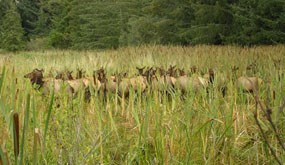
NPS Photo Join us Tracking and Watching Elk! Roosevelt Elk (Cervus elaphus rooseveltii) are a key component of the ecological and cultural resources of Lewis and Clark National Historical Park. Their abundance in this area was one of the primary reasons the Lewis and Clark Expedition chose the location of Fort Clatsop for their winter encampment. Of the original six subspecies of North American elk, only four remain. The largest of these is our Roosevelt elk, whose native range extends along the west coast of America from northern California to British Columbia. By the end of the 19th century, most of the Roosevelt elk in Oregon were eliminated by settler’s harvest. It is believed that the elk around Fort Clatsop were one of the last remaining groups. In the 1910s, these herds were used to reestablish populations in other areas of western Oregon where they had been extirpated. In 1938, the first legal hunt in Oregon in 38 years was allowed in the Fort Clatsop area. In order to better understand and manage for this key resource, US Geological Survey (USGS) and Lewis and Clark National Historical Park has begun a two-component monitoring program. The first component is a grid of permanent plots established across 1200 acres, where detailed data of elk use (represented by such signs as hoof prints, browsing, antler rubs, and pellets) will be collected and analyzed. This will give us a good picture of elk use within the park boundaries. Elk do not see these boundaries. Therefore a second component is needed if we want to understand elk distribution across the landscape. We are asking the public to help by reporting their elk sightings to us. The more information we have on what herds have been seen where, and when, the more accurate picture we will be able to paint of elk presence, abundance, and habitat use both within and outside of the official park borders. This information will help us, our neighbors, and our partners understand and care for these special animals, so long an integral part of our cultural and ecological heritage. Elk Sighting Forms are available here for download. We are working on an interactive website where you can report your sightings electronically. Until then, please send completed forms to:

NPS Photo 
|
Last updated: December 21, 2017
